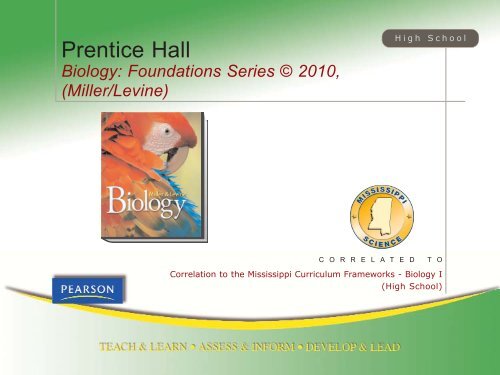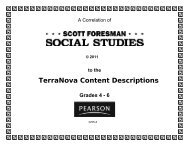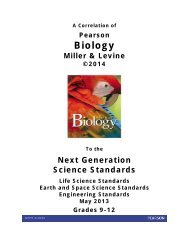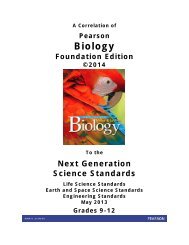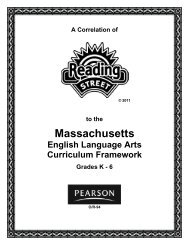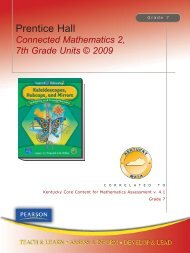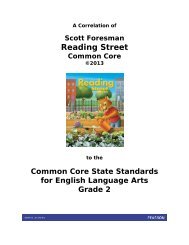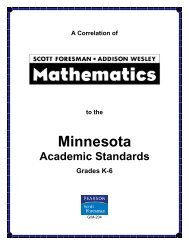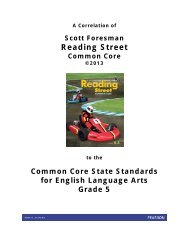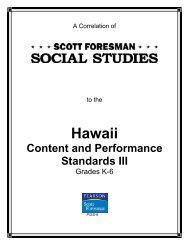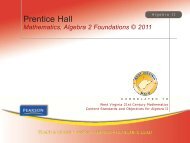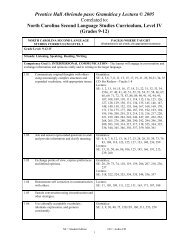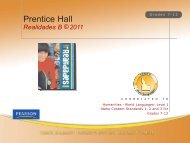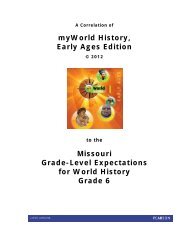Miller & Levine Biology - Pearson
Miller & Levine Biology - Pearson
Miller & Levine Biology - Pearson
You also want an ePaper? Increase the reach of your titles
YUMPU automatically turns print PDFs into web optimized ePapers that Google loves.
Prentice Hall<strong>Biology</strong>: Foundations Series © 2010,(<strong>Miller</strong>/<strong>Levine</strong>)High SchoolC O R R E L A T E D T OCorrelation to the Mississippi Curriculum Frameworks - <strong>Biology</strong> I(High School)
CONTENT STRANDS:Inquiry Physical ScienceLife SciencePEARSON<strong>Biology</strong>: Foundations Series © 2010, (<strong>Miller</strong>/<strong>Levine</strong>)CORRELATION TO THE MISSISSIPPI CURRICULUM FRAMEWORKSBIOLOGY I(HIGH SCHOOL)1. INQUIRY - Apply inquiry-based and problem-solving processes and skills to scientific investigations.Objectivesa. Conduct a scientific investigation demonstrating safe procedures and proper careof laboratory equipment. (DOK 2)Pupil EditionPage ReferencesTeacher EditionPage References• Safety rules and symbols 20, 24, 46, 74, 100,120, 130, 150, 162,184, 198, 204, 226,252, 280, 300, 370,386, 420, 470, 494,503, 520, 541, 544,553, 570, 579, 596,608, 617, 658, 660,688, 705, 734, 758,774, 778, 797, 802,852, A-11, A-12,A-13, A-14, A-15• Proper use and care of the compound light microscope, slides, chemicals, etc. 20, 46, 74, 120,150, 162, 184, 204,226, 252, 300, 370,20, 24, 46, 74, 100,120, 130, 150, 162,184, 198, 204, 226,252, 280, 300, 370,386, 420, 470, 494,503, 520, 541, 544,553, 570, 579, 596,608, 617, 658, 660,688, 705, 734, 758,774, 778, 797, 802,852, A-11, A-12,A-13, A-14, A-1520, 46, 74, 120,150, 162, 184, 204,226, 252, 300, 370,
PEARSON<strong>Biology</strong>: Foundations Series © 2010, (<strong>Miller</strong>/<strong>Levine</strong>)CORRELATION TO THE MISSISSIPPI CURRICULUM FRAMEWORKSBIOLOGY I(HIGH SCHOOL)• Accuracy and precision in using graduated cylinders, balances, beakers,thermometers, and rulersb. Formulate questions that can be answered through research and experimentaldesign. (DOK 3)c. Apply the components of scientific processes and methods in classroom andlaboratory investigations (e.g., hypotheses, experimental design, observations, dataanalyses, interpretations, theory development). (DOK 2)494, 503, 541, 579,596, 608, 617, 658,734, 79746, 74, 120, 150,184, 204, 226, 300,370, 494, 570, 638,688, 80246, 150, 252, 520,570, 705, 80211, 20, 32, 46, 66,74, 95, 100, 116,120, 130, 150, 162,184, 198, 213, 226,238, 252, 274, 280,299, 300, 325, 338,363, 370, 386, 398,413, 420, 435, 452,470, 492, 494, 503,520, 541, 544, 553,570, 579, 608, 617,632, 638, 658, 660,686, 688, 699, 705,733, 734, 755, 758,774, 778, 797, 802,822, 845, 852494, 503, 541, 579,596, 608, 617, 658,734, 79746, 74, 120, 150,184, 204, 226, 300,370, 494, 570, 638,688, 80246, 150, 252, 520,570, 705, 80211, 20, 32, 46, 66,74, 95, 100, 116,120, 130, 150, 162,184, 198, 213, 226,238, 252, 274, 280,299, 300, 325, 338,363, 370, 386, 398,413, 420, 435, 452,470, 492, 494, 503,520, 541, 544, 553,570, 579, 608, 617,632, 638, 658, 660,686, 688, 699, 705,733, 734, 755, 758,774, 778, 797, 802,822, 845, 852
PEARSON<strong>Biology</strong>: Foundations Series © 2010, (<strong>Miller</strong>/<strong>Levine</strong>)CORRELATION TO THE MISSISSIPPI CURRICULUM FRAMEWORKSBIOLOGY I(HIGH SCHOOL)d. Construct and analyze graphs (e.g., plotting points, labeling x-and y-axis, creatingappropriate titles and legends for circle, bar, and line graphs). (DOK 2)e. Analyze procedures, data, and conclusions to determine the scientific validity ofresearch. (DOK 3)f. Recognize and analyze alternative explanations for experimental results and tomake predictions based on observations and prior knowledge. (DOK 3)g. Communicate and defend a scientific argument in oral, written, and graphicform. (DOK 3)2. PHYSICAL SCIENCE - Describe the biochemical basis of life and explain howenergy flows within and between the living systems.Objectivesa. Explain and compare with the use of examples the types of bond formation (e.g.,covalent, ionic, hydrogen, etc.) between or among atoms. (DOK 2)46, 120, 150, 398,452, 80246, 150, 252, 520,570, 705, 80246, 150, 252, 520,570, 705, 80220, 46, 74, 120,150, 184, 204, 226,252, 280, 300, 370,398, 420, 494, 520,544, 570, 596, 617,705, 734, 758, 778,802, 852Pupil EditionPage References46, 120, 150, 398,452, 80246, 150, 252, 520,570, 705, 80246, 150, 252, 520,570, 705, 80220, 46, 74, 120,150, 184, 204, 226,252, 280, 300, 370,398, 420, 494, 520,544, 570, 596, 617,705, 734, 758, 778,802, 852Teacher EditionPage References• Subatomic particles and arrangement in atoms 28, 31, 47, 49 28, 31, 47, 49
PEARSON<strong>Biology</strong>: Foundations Series © 2010, (<strong>Miller</strong>/<strong>Levine</strong>)CORRELATION TO THE MISSISSIPPI CURRICULUM FRAMEWORKSBIOLOGY I(HIGH SCHOOL)• Importance of ions in biological processes 30-31, 32 30-31, 32b. Develop a logical argument defending water as an essential component of livingsystems (e.g., unique bonding and properties including polarity, high specific heat,surface tension, hydrogen bonding, adhesion, cohesion, and expansion uponfreezing). (DOK 2)33-34, 36, 47-49,5133-34, 36, 47-49,51c. Classify solutions as acidic, basic, or neutral and relate the significance of the pHscale to an organism’s survival (e.g., consequences of having differentconcentrations of hydrogen and hydroxide ions). (DOK 2)35-36, 49 35-36, 49d. Compare and contrast the structure, properties, and principle functions ofcarbohydrates, lipids, proteins, and nucleic acids in living organisms. (DOK 2)• Basic chemical composition of each group 38-41, 47-49, 720-72138-41, 47-49, 720-721• Building components of each group (e.g., amino acids, monosaccharides,nucleotides, etc.)38-41, 49 38-41, 49• Basic functions (e.g., energy, storage, cellular, heredity) of each group 38-41, 47 38-41, 47e. Examine the life processes to conclude the role enzymes play in regulatingbiochemical reactions. (DOK 2)• Enzyme structure 44-45, 46, 49-50 44-45, 46, 49-50
PEARSON<strong>Biology</strong>: Foundations Series © 2010, (<strong>Miller</strong>/<strong>Levine</strong>)CORRELATION TO THE MISSISSIPPI CURRICULUM FRAMEWORKSBIOLOGY I(HIGH SCHOOL)• Enzyme function, including enzyme-substrate specificity and factors that effectenzyme function (pH and temperature)f. Describe the role of adenosine triphosphate (ATP) in making energy available tocells. (DOK 1)44-45, 46, 47, 49-51, 724-726, 73744-45, 46, 47, 49-51, 724-726, 737• ATP structure 192-193, 207 192-193, 207• ATP function 192-194, 205, 207 192-194, 205, 207g. Analyze and explain the biochemical process of photosynthesis and cellularrespiration and draw conclusions about the roles of the reactant and products ineach. (DOK 3)• Photosynthesis and respiration (reactants and products) 196-197, 198, 199-203, 205-207, 209,213-215, 216-219,222, 227-229, 231• Light-dependent reactions and light independent reactions in photosynthesis,including requirements and products of each199-203, 205, 207,209196-197, 198, 199-203, 205-207, 209,213-215, 216-219,222, 227-229, 231199-203, 205, 207,209• Aerobic and anaerobic processes in cellular respiration, including products eachand energy differences3. LIFE SCIENCE - Investigate and evaluate the interaction between livingorganisms and their environment.213-215, 216-222,227-229, 231213-215, 216-222,227-229, 231
PEARSON<strong>Biology</strong>: Foundations Series © 2010, (<strong>Miller</strong>/<strong>Levine</strong>)CORRELATION TO THE MISSISSIPPI CURRICULUM FRAMEWORKSBIOLOGY I(HIGH SCHOOL)Objectivesa. Compare and contrast the characteristics of the world’s major biomes (e.g.,deserts, tundra, taiga, grassland, temperate forest, tropical rainforest). (DOK 2)Pupil EditionPage ReferencesTeacher EditionPage References• Plant and animal species 92-94, 96-99, 101,103-104• Climate (temperature and rainfall) 92-94• Adaptations of organisms 92-9492-94, 96-99, 101,103-10492-9492-94b. Provide examples to justify the interdependence among environmental elements.(DOK 2)• Biotic and abiotic factors in an ecosystem (e.g., water, carbon, oxygen, mold,leaves)• Energy flow in ecosystems (e.g., energy pyramids and photosynthetic organisms toherbivores, carnivores, and decomposers)57-59, 68-73, 74,75-79, 82-84, 100,101-10257-59, 68-73, 74,75-79, 82-84, 100,101-10263-67, 75-77 63-67, 75-77• Roles of beneficial bacteria 488, 495, 497 488, 495, 497• Interrelationships of organisms (e.g., cooperation, predation, parasitism,commensalism, symbiosis, and mutualism)86-87, 101-103,105, 113-115, 116,121, 123-124, 511-86-87, 101-103,105, 113-115, 116,121, 123-124, 511-
PEARSON<strong>Biology</strong>: Foundations Series © 2010, (<strong>Miller</strong>/<strong>Levine</strong>)CORRELATION TO THE MISSISSIPPI CURRICULUM FRAMEWORKSBIOLOGY I(HIGH SCHOOL)c. Examine and evaluate the significance of natural events and human activities onmajor ecosystems (e.g., succession, population growth, technology, loss of geneticdiversity, consumption of resources). (DOK 2)4. Analyze and explain the structures and function of the levels of biologicalorganization.513, 646 513, 64688-90, 101-103, 88-90, 101-103,105, 108-111, 112- 105, 108-111, 112-115, 116, 120, 121- 115, 116, 120, 121-125, 128-137, 140- 125, 128-137, 140-142, 143-149, 150, 142, 143-149, 150,151-155151-155a. Differentiate among plant and animal cells and eukaryotic and prokaryotic cells.(DOK 2)• Functions of all major cell organelles and structures (e.g., nucleus, mitochondrion,rough ER, smooth ER, ribosomes, Golgi bodies, vesicles, lysosomes, vacuoles,microtubules, microfiliaments, chloroplast, cytoskeleton, centrioles, nucleolus,chromosomes, nuclear membrane, cell wall, cell membrane [active and passivetransport], cytosol)164-175, 176-180,185-187, 195, 218,222164-175, 176-180,185-187, 195, 218,222• Components of mobility (e.g., cilia, flagella, pseudopodia) 485-486, 505-506,508, 523b. Differentiate between types of cellular reproduction. (DOK 1)485-486, 505-506,508, 523• Main events in the cell cycle and cell mitosis (including differences in plant andanimal cell divisions240-244, 253-257 240-244, 253-257
PEARSON<strong>Biology</strong>: Foundations Series © 2010, (<strong>Miller</strong>/<strong>Levine</strong>)CORRELATION TO THE MISSISSIPPI CURRICULUM FRAMEWORKSBIOLOGY I(HIGH SCHOOL)• Binary fission (e.g., budding, vegetative propagation, etc.) 487-488 487-488• Significance of meiosis in sexual reproduction 275-280, 281-282, 275-280, 281-282,284-285284-285• Significance of crossing over 276, 278 276, 278c. Describe and differentiate among the organizational levels of organisms (e.g.,cells, tissues, organs, systems, types of tissues.) (DOK 1)d. Explain and describe how plant structures (vascular and nonvascular) andcellular functions are related to the survival of plants (e.g., movement of materials,plant reproduction). (DOK 1)5. Demonstrate an understanding of the molecular basis of heredity.a. Analyze and explain the molecular basis of heredity and the inheritance of traitsto successive generations by using the Central Dogma of Molecular <strong>Biology</strong>. (DOK3)248-251, 256, 552-555, 556-559, 560-563, 564-565, 571-574, 597-600, 714-716, 735, 737532-535, 536-539,540-541, 543, 545-549, 552-555, 556-559, 560-563, 564-566, 567-569, 571-575, 578-584, 585-587, 588-592, 597-601248-251, 256, 552-555, 556-559, 560-563, 564-565, 571-574, 597-600, 714-716, 735, 737532-535, 536-539,540-541, 543, 545-549, 552-555, 556-559, 560-563, 564-566, 567-569, 571-575, 578-584, 585-587, 588-592, 597-601• Structures of DNA and RNA 292-295, 301-303, 292-295, 301-303,
PEARSON<strong>Biology</strong>: Foundations Series © 2010, (<strong>Miller</strong>/<strong>Levine</strong>)CORRELATION TO THE MISSISSIPPI CURRICULUM FRAMEWORKSBIOLOGY I(HIGH SCHOOL)305, 308-310, 327,329, 331305, 308-310, 327,329, 331• Processes of replication, transcription, and translation 296-299, 301, 303-305, 309-310, 311-315, 327-329, 331296-299, 301, 303-305, 309-310, 311-315, 327-329, 331• Messenger RNA codon charts 311 311b. Utilize Mendel’s laws to evaluate the results of monohybrid Punnett squaresinvolving complete dominance, incomplete dominance, codominance, sex linked,and multiple alleles (including outcome percentage of both genotypes andphenotypes.) (DOK 2)266-270, 271, 283 266-270, 271, 283c. Examine inheritance patterns using current technology (e.g., pedigrees,karyotypes, gel electrophoresis). (DOK 2)d. Discuss the characteristics and implications of both chromosomal and genemutations. (DOK 2)334, 336-337, 342-345, 347-351334, 336-337, 342-345, 347-351• Significance of nondisjunction, deletion, substitutions, translocation, frame shiftmutation in animals316-319, 327-330 316-319, 327-330• Occurrence and significance of genetic disorders such as sickle cell anemia, Tay-Sachs disorder, cystic fibrosis, hemophilia, Downs Syndrome, color blindness6. Demonstrate an understanding of principles that explain the diversity of life andbiological evolution.338, 339-341, 347-351338, 339-341, 347-351
PEARSON<strong>Biology</strong>: Foundations Series © 2010, (<strong>Miller</strong>/<strong>Levine</strong>)CORRELATION TO THE MISSISSIPPI CURRICULUM FRAMEWORKSBIOLOGY I(HIGH SCHOOL)a. Draw conclusions about how organisms are classified into a hierarchy of groupsand subgroups based on similarities that reflect their evolutionary relationships.(DOK 2)• Characteristics of the six kingdoms 438-441, 446, 514-516, 519, 521, 528-529, 606-607,DIVERSITY OFLIFE: 6,DIVERSITY OFLIFE: 8,DIVERSITY OFLIFE: 10,DIVERSITY OFLIFE: 16,DIVERSITY OFLIFE: 20,DIVERSITY OFLIFE: 30• Major levels in the hierarchy of taxa (e.g., kingdom, phylum/division, class, order,family, genus, and species)430-432, 443, 445,447438-441, 446, 514-516, 519, 521, 528-529, 606-607,DIVERSITY OFLIFE: 6,DIVERSITY OFLIFE: 8,DIVERSITY OFLIFE: 10,DIVERSITY OFLIFE: 16,DIVERSITY OFLIFE: 20,DIVERSITY OFLIFE: 30430-432, 443, 445,447• Body plans (symmetry) 611, 614, 616, 620 611, 614, 616, 620• Methods of sexual reproduction (e.g., conjugation, fertilization, pollination) 464-465, 507-508, 464-465, 507-508,
PEARSON<strong>Biology</strong>: Foundations Series © 2010, (<strong>Miller</strong>/<strong>Levine</strong>)CORRELATION TO THE MISSISSIPPI CURRICULUM FRAMEWORKSBIOLOGY I(HIGH SCHOOL)• Methods of asexual reproduction (e.g., budding, binary fission, regeneration, sporeformation)530-531, 579-582,584, 678-683, 689-692530-531, 579-582,584, 678-683, 689-692487-488, 583-584 487-488, 583-584b. Critique data (e.g., comparative anatomy, Biogeography, molecular biology, fossilrecord, etc.) used by scientists (e.g., Redi, Needham, Spallanzani, Pasteur) todevelop an understanding of evolutionary processes and patterns. (DOK 3)c. Research and summarize the contributions of scientists, (including Darwin,Malthus, Wallace, Lamarck, and Lyell) whose work led to the development of thetheory of evolution. (DOK 2)d. Analyze and explain the roles of natural selection, including the mechanisms ofspeciation (e.g., mutations, adaptations, geographic isolation) and applications ofspeciation (e.g., pesticide and antibiotic resistance). (DOK 3)e. Differentiate among chemical evolution, organic evolution, and the evolutionarysteps along the way to aerobic heterotrophs and photosynthetic autotrophs. (DOK2)392-395, 397, 399-402, 450-455, 456-461, 471-474, 624-627380-383, 384-386,387, 388, 399-403388-391, 396-397,399-403, 409-413,414-416, 420, 421-424395, 397, 399-402,406-408, 417-419,421-424, 462-464392-395, 397, 399-402, 450-455, 456-461, 471-474, 624-627380-383, 384-386,387, 388, 399-403388-391, 396-397,399-403, 409-413,414-416, 420, 421-424395, 397, 399-402,406-408, 417-419,421-424, 462-464‣ All competencies and objectives must be listed even though you may not correlate to the competencies and/or objectives. Pleasewrite "NA" in the page reference if there is no correlation.
PEARSON<strong>Biology</strong>: Foundations Series © 2010, (<strong>Miller</strong>/<strong>Levine</strong>)CORRELATION TO THE MISSISSIPPI CURRICULUM FRAMEWORKSBIOLOGY I(HIGH SCHOOL)‣ If you have an annotated teacher edition (ATE), then you may correlate to that one book as it contains both the pupil and teacheredition. Please indicate that you are correlating to the ATE.‣ If you have a series of books that are being submitted, please do a correlation for each book. Each book's correlation should standalone.


